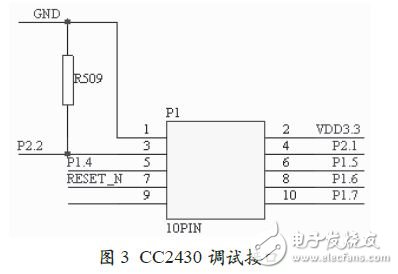0 Preface
In recent years, wireless sensor network technology has developed rapidly. Due to the free and open characteristics of the 2.4 GHz communication band, various communication protocols based on this frequency band, such as Wi-Fi and Bluetooth, are quite mature and widely used. ZigBee is a low-power personal area network protocol based on the IEEE802.15.4 standard. The protocol is based on the 2.4 GHz band and is a low-cost, low-power short-range wireless networking communication technology. In the field of radio frequency communication, such as regional positioning, line-of-sight data transmission, Internet of Things tags, automotive wireless electronic devices, etc.
The SOC (system on a chip) represented by Chipcon's ZigBee-based series of products is also maturing. Therefore, the design of a low-cost, stable performance, fully functional development system has always been an important component of related research. This paper presents a hardware design scheme for RF wireless sensor network nodes based on ZigBee and 51 cores. The design revolves around Chipcon's CC2430 chip, which meets the physical layer requirements of the ZigBee protocol and integrates a 51-core MCU at a low price with good development potential. The design adopts a modular design method and can be applied to various software and hardware development based on ZigBee protocol. This program will detail the principles and design methods of each module.
1 system overall framework
The system is generally divided into two parts: the first part is the controller and RF module part; the second part is the peripheral expansion circuit part. The specific system framework diagram is shown in Figure 1.

2 controller and RF module design
The main control circuit is the core of the whole system, which is responsible for the overall scheduling and control of the entire node. Taking into account the convenience of equipment operation and maintenance, system integration and other characteristics, the main control circuit can store a certain amount of data in addition to the data processing capability. This design uses the RF chip CC2430 based on ZigBee technology as the core. The device integrates a 51-core MCU controller with an RF transceiver, so the controller module and RF module sections are in an overall design mode. At the same time, the chip also has FLASH memory, which can store data conveniently. The device has small volume, stable performance, fast calculation speed and good expandability, and can better meet the various needs of the design.
2.1 CC2430 controller circuit configuration
In this design, the main control unit undertakes functions such as peripheral device expansion and control, A/D conversion, and data transmission. The CC2430 is a highly integrated SOC system with a compact I/O port and reusable functions. Therefore, it is necessary to save the I/O port as much as possible in the design and expand it if necessary. At the same time, the design should also have online download and debug functions to facilitate the needs of engineering applications.
2.1.1 I/O Port Configuration
The CC2430 has 21 digital I/O port pins, P0, P1, and P2. They are all 8-bit I/O ports. Each port can be individually set to general purpose I/O or external device I/O. All but the two high output ports P1_0 and P1_1 are used for output. The I/O ports related to this design are reserved by means of connectors to facilitate the use and expansion of different occasions, as shown in Figure 2.

2.1.2 Debugging Interface
This design CC2430 has online debugging and downloading functions, which can be freely configured as needed. Figure 3 shows the CC2430 debug interface diagram, which consists of debug interface pins P2.2 and P2.1, which are used as debug clock and debug data signal pins, respectively.

Yuhai company develop and produce of
various rings sizes, bearing variety of electrode and metallisation
configurations. This variety of Rings is fabricated from various material
formulations for applications such as high power, sensitivity, stability.
Features
·
• electrode type on request
·
• Surface roughness on request, for specific demanding application
·
• Thickness/Radial frequency tuning
available on request
• Wide choice of PZT
formulations
Applications include
• Sensors
• Welding
•
Ultrasonic
cleaning
• Precise Measurement
• Ultrasonic scalpel
• Cauterisation
• Phacoemulsification
•
Therapeutic
ultrasound
• Accelerometers
Dimension range
|
Outer diameter
|
3-180mm
|
|
Inner diameter
|
1-150mm
|
|
Thickness
|
0.2-25mm
|
PZT Piezoelectric Rings
Piezo Ring,Pzt Ring,Piezoelectric Ceramic Ring,Piezo Ceramic Ring
Zibo Yuhai Electronic Ceramic Co., Ltd. , https://www.yhpiezo.com